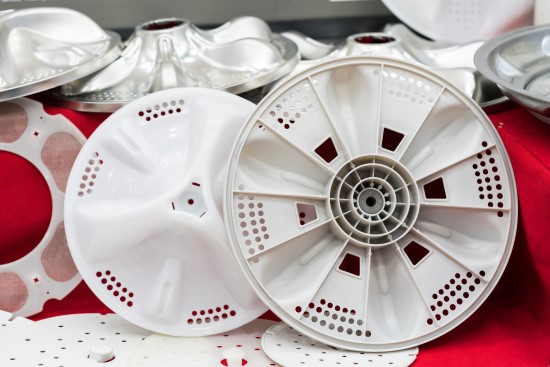When it comes to plastic parts, we tend to levitate towards using one of two primary production technologies: Injection Molding and Urethane Casting.
Where it fits, Urethane casting of plastic parts is an amazing technology. The process starts by 3D printing or CNC machining a part with as much detail as might be required, including surface finishes. This part is then used to create a mold using silicone. This is the key difference. Other casting processes require the manufacturer to buy a very expensive mold that can take weeks to produce. With silicon-based molds made from CNC machined or 3D printed master the cost of the molding process is reduced significantly.
Of course, there are drawbacks, silicon molds don’t last as long as hard molds. The good news is they are easy to make (and less costly). Urethane casting can be an excellent technology to used for small and medium scale manufacturing runs.
After curing the silicone in an oven, the mold is cut in half. With a few more steps it is ready for casting. This involves pouring a urethane casting resin into the cavity and curing.
Urethane casting is extremely versatile and suitable for parts ranging from medical, electronics enclosures, toys, IT equipment, industrial, household and more.
Injection molding, on the other hand, starts with hard molds made from aluminum or steel. While the cost of the this tooling is substantially higher and fabrication time longer, this kind of tooling can produce orders of magnitude more parts per mold when compared to the kinds of molds used in Urethane casting.
Another interesting difference is that the injection molding process does not require curing in an oven. Plastic resin is injected at high temperature and pressure into the mold. The plastic cures and solidifies quickly. This allows for high cycle times and more parts per day than other methods.
Injection molding and Urethane casting also differ in one important aspect: It is much easier and less costly to modify a part during development by using Urethane casting. Changes and small runs can be executed quickly due to the cost-effectiveness of the tooling.
This is not to say one must choose between these processes. Not at all. In fact, they are often used together. During development and initial small runs Urethane casting is used due to cost and timeline advantages. Once the design has matured, if production volumes allow it, injection molding comes into the fold for a potentially significant reduction in manufacturing costs and much larger production capacity per day.
We can help you design entire products from just an idea, design specific parts for production or navigate various manufacturing options for your products. We can help you manufacture a few parts for prototyping or manage your entire at-scale production process. Get in touch. We can help.
